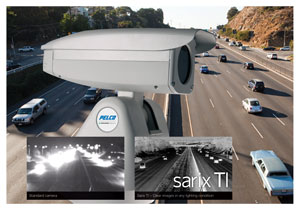
|
|
The Sarix TI Thermal camera provides clear images of moving vehicles in nighttime conditions, as this side-by-side comparison shows. PHOTO COURTESY OF PELCO BY SCHNEIDER ELECTRIC |
As loyal readers are aware, my daughter and I are rapidly preparing for the upcoming zombie apocalypse. As fervent viewers of “The Walking Dead,” we came to the decision that the addition of a crossbow to our growing arsenal was in order. After receiving the weapon (there should be some way to limit the per-day dollars that can be spent ordering stuff over the Internet) we took the crossbow to our summer cabin in Michigan to have some target shooting fun. Unfortunately, the weather had turned to winter, and the idea of standing out in the freeze was not attractive to us. So into the basement bunker we went and worked on zeroing the crossbow scope.
It was at this point I remembered that I cannot see very well, particularly if the lighting is bad. My history of eyesight-related issues started in second grade. My parents (who were from the school of “the only time you take your child to the doctor is if a bone is sticking out”) finally figured out why I had to sit three feet from the TV while the rest of the family could sit on the couch 12 feet back. One set of near-sighted corrective glasses later, and my eyesight was close to acceptable.
Just like my eyesight, CCTV cameras need adequate light to provide usable images for real-time and recorded viewing and analysis. During partial or full dark conditions, some form of lighting must be provided; otherwise, the images from the camera will be blacked out. Our industry has provided infrared LED lighting for many years and this technology works well for relatively small areas.
However, what do we do when we need to detect and protect a large outdoor area from nocturnal human intruders?
One issue when attempting to provide surveillance for large outdoor areas is that a clever intruder can camouflage his clothing and movements to make it difficult even for an alert viewer to see a person from 3,000 feet away. Some industry professionals would cry, “More cameras! More lights!” to solve this issue but those exhortations either will kill the project (because of the high cost of more cameras, lights, and electricity) or the client ends up with a system that cannot provide the level of security needed because the job just can’t be done with standard color surveillance cameras, whether IP or analog.
Enter the thermal imaging camera, made famous in many quasi-scientific television shows such as “Mythbusters.” The imaging devices in these cameras detect the emitted thermal energy of both an intruder and the background, and they will present the thermal images in a sort of reversed black-and-white frame with the detected human presented as a moving red image. These cameras will present the same type of viewing screen whether it is daytime or nighttime.
One company involved with thermal imaging is Pelco by Schneider Electric. The company’s Sarix TI camera series offers both flexibility and innovation. The Sarix TI cameras come in both fixed and pan-tilt-zoom (PTZ) models, with the expected environmental housings needed, as thermal cameras naturally will be used in outdoor installations. The cameras provide both an IP and analog video output, so they are quickly and easily integrated into existing surveillance systems and will work with the major brands of VMS software.
The cameras get their thermal imaging capability from the use of sunlight-safe microbolometers, which are the image sensors that are used to detect an object’s thermal energy emission. Sounds complicated, but the results are outstanding detection of human and vehicular targets of interest at huge distances. When using the Sarix TI camera in its 640 x 480 resolution format with a 100 mm lens, human targets can be detected as far away as two miles, while vehicles can be seen as far as 4.7 miles away.
There are many potential advantages and uses for this technology. Perimeter detection can be provided by using the fixed or PTZ Sarix TI cameras and, most importantly, no external lighting is required. The Sarix TI cameras will reliably provide thermal imaging through fog, rain, and snow with little or no loss of resolution or range.
Where this manufacturer has stepped up is the incorporation of the thermal image analytics into the cameras themselves. Each camera’s programming can be tailored individually for the viewing of a specific area. When specified targets are viewed, the camera can provide detailed alarm information to a Pelco DSSRV VMS device or software package, where the detection of a human or vehicle intruder can generate onscreen alarms, emails and text messages. The Sarix TI series of cameras also will integrate with some other VMS programs, and the camera itself has a programmable contact closure that can be used in any way that is practical to annunciate the detection of an intruder. Detailed information about the Sarix TI cameras along with a very cool video demonstration of the viewing capabilities of these Pelco cameras may be found at http://www.pelco.com/sites/global/en/products/camera-solutions/sarix-ti-thermal-imaging.page.
I strongly recommend this technology for use in large open-field, parking lot, or sizeable outdoor installations. No more remote cameras at the other end of the parking lot with their associated cabling costs, installation difficulties and service issues. The cameras stay on the sides of the building, where they belong.
Smart security dealers will get their local Pelco representatives involved when planning to use the Sarix TI technology at a client’s location so that the value of these high-tech cameras is maximized for the customer’s use.
Now I have to take the scope off the crossbow. At this point, I can still see iron sights — and zombies are slow-moving, if persistent, targets.
This article was previously published in the print magazine as "No Lights, Big City."







